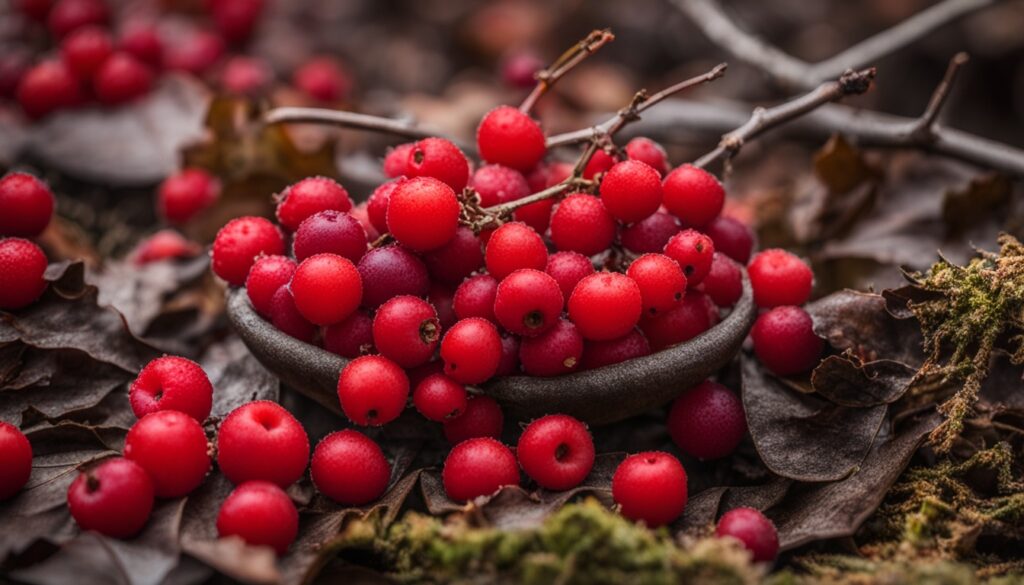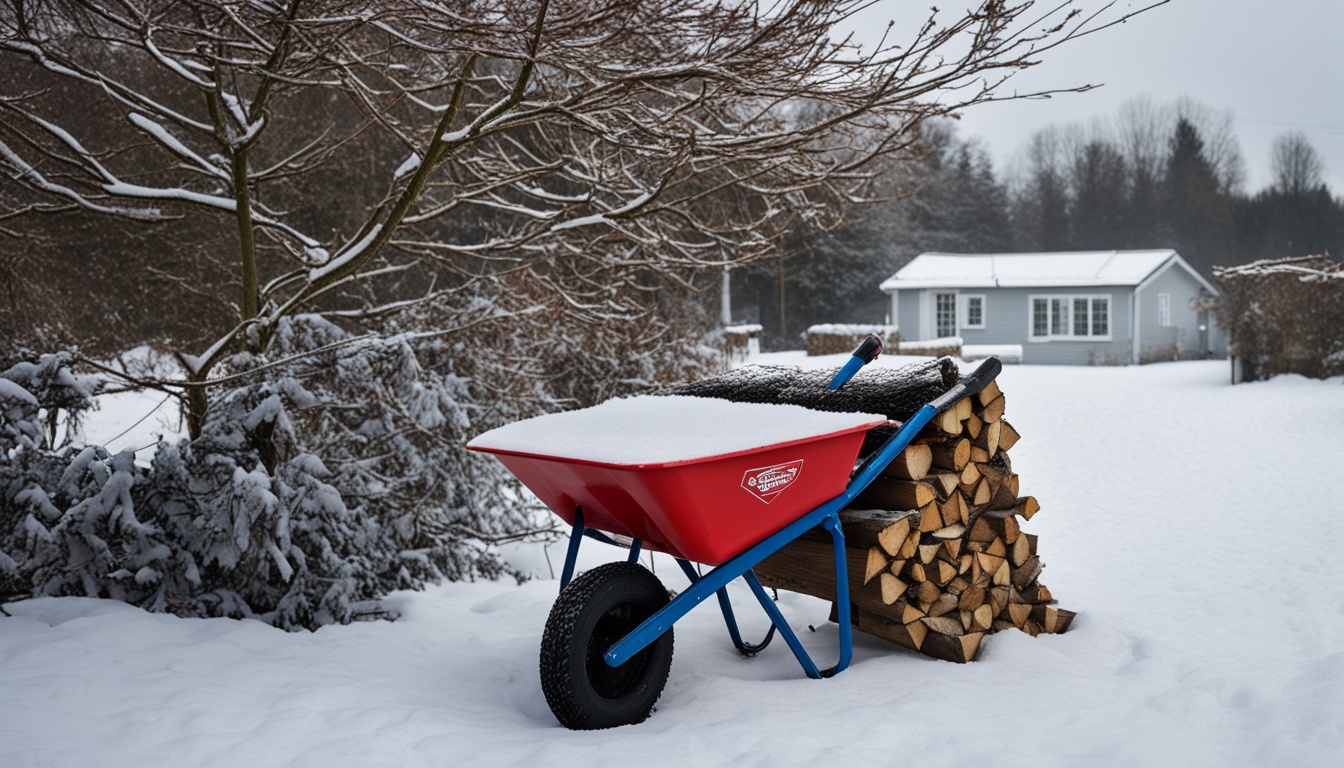As the temperatures drop and days get shorter, it’s time to get your garden ready for winter. You need to protect your plants, tools, and garden beds from the cold. By winterizing your garden, you’ll have a healthy garden come spring.
Key Takeaways
- Protecting plants in winter is key for a great spring garden.
- Know the needs of tender, hardy, and semi-hardy vegetables for winter prep.
- Keep your garden tools and equipment in good shape for next season.
- Get your berry patches, perennials, and roses ready for the cold.
- Prune and protect your trees and shrubs to avoid winter damage.
Harvesting and Storing Vegetables
Tender Vegetables
Vegetables like tomatoes, zucchini, peas, beans, winter squash, and pumpkins can’t handle frost. Harvest them before the first frost. Remove any plants and debris, but throw out any sick ones to stop disease from spreading.
Hardy Vegetables
Brussels sprouts, kale, collards, broccoli, and spinach can get through hard frosts (25°F to 28°F). They might even taste better after a light frost. These are great for gardening in the cold.
Semi-hardy Vegetables
Cabbages, Swiss chard, arugula, leeks, mustard greens, cauliflower, English peas, and Kohlrabi can handle light frosts (29°F to 32°F). They might need some extra protection, like a cold frame or row cover. Carrots, turnips, beets, rutabagas, and parsnips can stay in the garden after a frost. Dig and store them before the ground freezes.
| Vegetable Type | Frost Tolerance | Recommended Overwintering Technique |
|---|---|---|
| Tender Vegetables | Do not tolerate frost | Harvest before first frost |
| Hardy Vegetables | Tolerate hard frosts (25°F to 28°F) | Can be left in the ground |
| Semi-hardy Vegetables | Tolerate light frosts (29°F to 32°F) | Benefit from protection (cold frames, floating row covers) |
Knowing how cold-hardy your vegetables are helps you harvest and store them right. This way, you’ll have fresh produce all winter.
Preparing Herbs for Winter
As winter comes, gardeners must think about their herb plants. Some herbs like sage and thyme can handle the cold. But others, like rosemary and basil, need extra care to stay alive. Planning and preparing are crucial to help your herbs survive the cold.
For hardy herbs, overwintering is easy. These tough plants can stay outside, but adding mulch or straw helps keep them warm. Tender herbs need more protection to avoid freezing and drying out.
There are ways to keep herbs fresh during winter. Drying is a common method that keeps the flavors. Freezing is also good, keeping herbs tasty and fresh. If you have space, potting up herbs and keeping them inside can give you fresh flavors all winter.
| Herb Type | Winter Care |
|---|---|
| Hardy Herbs (e.g., sage, thyme) | Can be left in the garden with a layer of mulch or straw for added protection |
| Tender Herbs (e.g., rosemary, basil) | Need to be brought indoors or given more substantial protection to prevent freezing |
| All Herbs | Can be dried, frozen, or potted up and brought inside to extend their growing season |
Knowing what your herbs need and how to protect, store, and preserve them ensures your garden stays flavorful even in winter.
Covering Garden Beds
As the gardening season ends, it’s time to get your garden ready for winter. Proper preparation boosts soil health, stops weeds, and gets your garden ready for spring.
Adding compost or well-rotted manure to your garden beds is a great move. This stuff slowly feeds the soil during the cold months. It also makes the soil better at holding water and nutrients, helping your garden grow strong next year.
For a low-maintenance option, try planting cover crops like winter rye or clover. These plants keep weeds away, stop soil from washing away, and add good stuff to the soil when you till it in next year.
For extra protection, put straw, leaves, or organic mulch on top of your beds. This keeps the soil warm, holds moisture in, and stops weeds from growing.
Or, you can use black plastic or cardboard to kill weeds and stop new ones from starting. This is great for areas where weeds won’t quit.
“Caring for your garden in the off-season is just as important as tending to it during the growing months. By taking the time to properly cover and protect your beds, you’ll be rewarded with healthier, more vibrant plants in the spring.”
No matter what method you pick, make sure your garden beds are covered and safe over winter. This keeps the soil healthy and gets your garden ready for a great growing season next year.
Preparing Berry Patches for Winter
As winter comes, it’s key to get your berry patches ready. Taking the right steps ensures a great harvest next year. Let’s look at how to prepare your berries for the cold season.
Pruning Berries
Pruning is crucial for your berry plants’ health and productivity. For summer-bearing raspberries, cut back the canes to keep the strongest ones. Fall-bearing raspberries should have their canes cut to the ground. This lets new growth start in spring. Blackberries should be planted in the fall and have soil mounded around the canes to protect the roots.
Mulching Berries
Mulching blueberry plants and strawberry beds is key for winter protection. Mulch keeps roots warm, holds in moisture, and stops soil from freezing and thawing. This is bad for the plants.
| Berry Type | Pruning Recommendations | Mulching Recommendations |
|---|---|---|
| Summer-bearing Raspberries | Prune canes, leaving the most vigorous ones | N/A |
| Fall-bearing Raspberries | Cut canes back to the ground | N/A |
| Blackberries | Plant in the fall, mound soil around canes | N/A |
| Blueberries | N/A | Mulch plants |
| Strawberries | N/A | Mulch beds |
By following these overwintering berries, pruning berries, mulching berries, and winter berry care tips, your berry patches will be ready for winter. This prepares you for a successful harvest in the future.

Winterizing Perennials
As winter comes, it’s key to get your perennial plants ready. This means “winterizing” them to help them survive and grow back in spring. Cutting them back and protecting them from the cold are the main steps.
Cutting Back Perennials
Some perennials can wait for spring to be cut back. But others, like bee balm, phlox, and hostas, should be trimmed in fall to stop diseases. Cut them back after the ground freezes and leaves die, leaving 3 inches of stem. Then, mulch them with leaves or straw for extra protection.
Protecting Perennials
For potted perennials, move them to a safe place when their flowers fade. Water them well and cover with straw to overwinter them. Tender bulbs, like dahlias, gladioli, and cannas, should be dug up, dried, and kept in a dark, humid spot at 40°F to 50°F until spring. This protects them from the cold.
By cutting back perennials and protecting them from the elements, your garden will thrive when it gets warmer. These easy steps help your overwintering perennials stay healthy and last longer.
Winterizing Roses
As winter comes, it’s key to winterize your roses to keep them alive and blooming next year. Roses need special care during this time. With the right steps, you can shield them from winter’s harshness.
Start by watering your roses often in the fall but don’t feed them six weeks before the first frost. This gets them ready for sleep and stops new growth that could freeze. Then, check your rose bushes for dead or sick canes. Remove them to stop pests and diseases from spreading.
To protect your roses, mulch their base with compost or leaves, covering up to where the stem meets the roots. This keeps roots warm and moist. For really cold areas, wrap low-growing roses in a strong cylinder with straw or evergreen branches inside.
For climbing and tea roses, you’ll need to do something different. Bend the long canes down, lay them flat, and cover them with pine branches or more mulch. This protects the weak spots from the cold and helps them make it through winter.
By taking these easy steps, your rose garden will be ready for winter. This means more beautiful flowers in the spring.

| Rose Variety | Winterization Technique |
|---|---|
| Low-growing Roses | Enclose in sturdy cylinder, fill with protective materials |
| Climbing and Tea Roses | Carefully pull down canes, lay flat, and cover with mulch or pine branches |
Preparing Trees and Shrubs for Winter
As winter comes, it’s important to get your trees and shrubs ready. The right timing is crucial for pruning trees and shrubs. Also, protecting young trees from the cold is key.
Pruning Trees and Shrubs
Don’t prune your trees and shrubs just before winter. This can make them grow new, tender parts that freeze easily. Wait for spring to prune instead. Pruning in fall makes them more likely to suffer winter damage.
Pruning in the dormant season helps your plants face winter tree care and winter shrub care better.
Protecting Young Trees
To keep young trees safe, wrap their trunks with a tree wrap. This protects the bark from splitting in cold weather. For small trees and shrubs, cover them with a wooden structure or wrap them in burlap or heavy plastic.
This keeps them safe from heavy snow. These steps help protect young trees and make sure they make it through winter.
“Proper winterization of trees and shrubs is essential for their long-term health and vitality.”
Conclusion
As the year ends, take pride in your garden’s winter prep. You’ve made sure your plants, tools, and beds are safe and ready for spring. By harvesting and storing your veggies and winterizing trees and perennials, you’ve shown your dedication to winter garden preparation.
This hard work means your seasonal gardening will be rich and full. Garden winterization is more than just protecting plants. It keeps your garden healthy and long-lasting.
By winterizing your garden, you’re getting ready for a great gardening season. This will let you enjoy your garden’s beauty and harvest fully.
Enjoy the cold months knowing your garden is ready for spring. Your effort and care will lead to a garden that brings you joy and satisfaction for many years.
FAQ
Q: What should I do with tender vegetables before the first frost?
A: Before the first frost, harvest tender veggies like tomatoes, zucchini, and peas. Remove these plants and any debris, making sure to discard any diseased plants to stop disease spread.
Q: How can I protect hardy and semi-hardy vegetables in the winter?
A: Hardy veggies like Brussels sprouts and kale can handle hard frosts. Semi-hardy ones, such as cabbages and broccoli, might need protection like cold frames or row covers.
Q: How can I prepare herbs for the winter?
A: Some herbs like sage can handle the cold. Others, like basil, need protection or indoor care. You can dry, freeze, or pot them up to keep their season going.
Q: How should I prepare my garden beds for the winter?
A: Add compost or manure to your beds in late autumn for nutrient absorption. Use straw or mulch to prevent erosion and weed growth. Or, plant cover crops or cover the beds with plastic or cardboard to kill weeds.
Q: How do I prepare berry patches for the winter?
A: Prune summer raspberries and cut back fall ones to the ground. Plant blackberries in the fall and mound the soil around the canes. Mulch around blueberries and strawberries for extra protection.
Q: How should I prepare perennials for the winter?
A: Cut back perennials like bee balm and hostas in the fall. Wait for the ground to freeze before cutting, leaving 3 inches of stem. Mulch them for protection. For potted perennials, move them to a sheltered spot and cover with straw.
Q: How do I winterize roses?
A: Water roses well in the fall but don’t fertilize them six weeks before frost. Cut off dead or diseased canes and mulch the plants. Use protective materials for low-growing roses and lay down long canes of climbing roses.
Q: How should I prepare trees and shrubs for the winter?
A: Don’t prune trees and shrubs before winter to avoid new growth damage. Prune in spring instead. Wrap young tree trunks with a protective wrap to keep out mice and voles. Use a wooden structure or cover them in burlap or plastic for small trees and shrubs.






